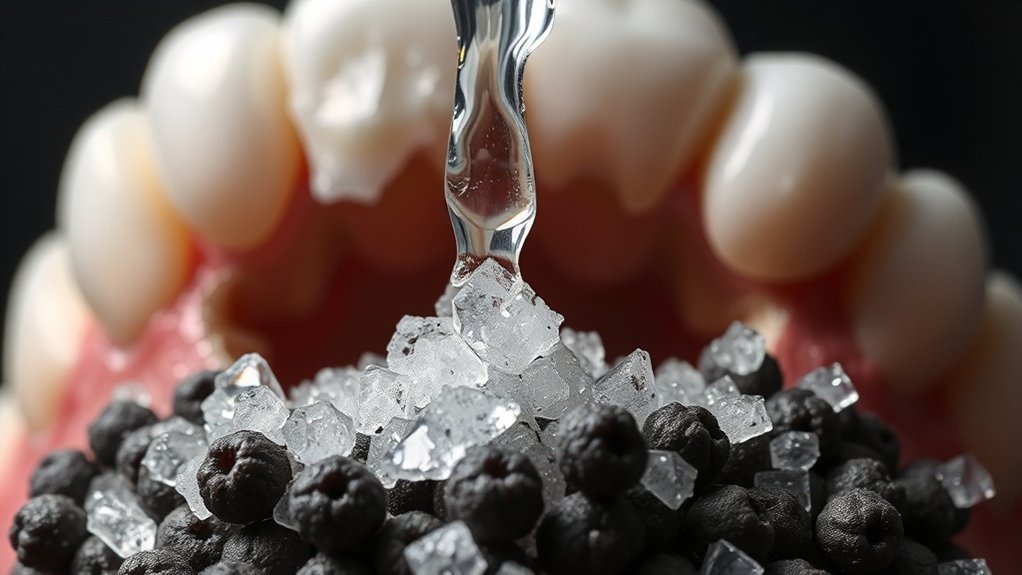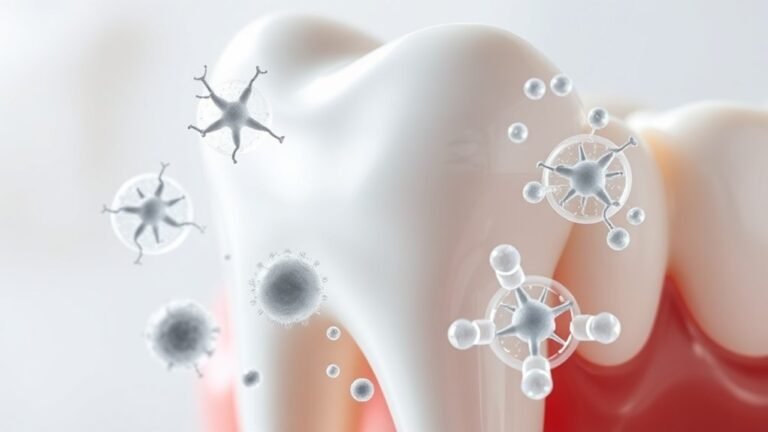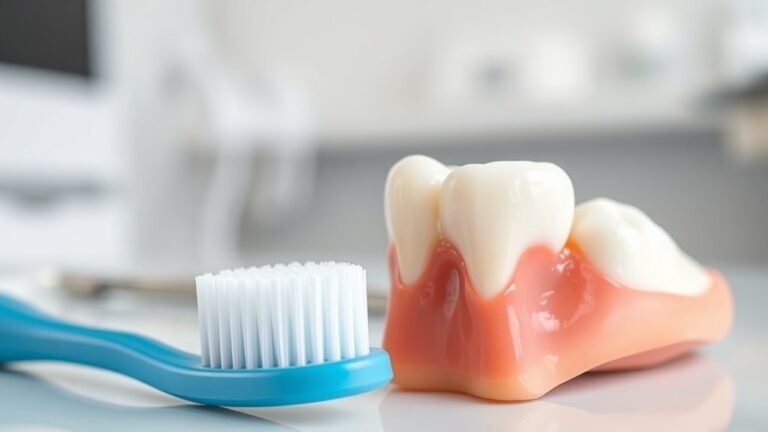Streptococcus Mutans Feed on Sugar and Increase Cavity Risk
Streptococcus mutans thrives on sugar, rapidly converting it into acids that erode tooth enamel, markedly increasing your cavity risk. When you consume sugary foods, S. mutans becomes more active, producing organic acids that lower oral pH and encourage tooth decay. Factors like the type and frequency of sugar, along with your oral hygiene habits, heavily influence S. mutans growth. To protect your dental health, it’s essential to understand these dynamics further and how to counteract them effectively.
Key Takeaways
- Streptococcus mutans metabolizes sugars, producing acids that erode tooth enamel and lead to cavities.
- Frequent sugar exposure significantly increases S. mutans activity and acid production.
- Acidic conditions from sugar fermentation promote enamel demineralization, resulting in cavity formation.
- Oral hygiene practices, like brushing and flossing, are essential to control S. mutans growth.
- Limiting sugar intake and choosing healthier alternatives can reduce cavity risk associated with S. mutans.
Understanding Streptococcus Mutans: The Cavity-Causing Bacteria
While you may not realize it, Streptococcus mutans plays an essential role in the development of dental cavities. This bacterium resides in your mouth, forming biofilms on tooth surfaces and contributing to cavity risk. When you consume sugars, S. mutans metabolizes them, producing acids that erode enamel and lead to tooth decay. The more frequently you expose your teeth to these sugars, the greater the opportunity for S. mutans to thrive and produce harmful acids. Understanding the behavior of this cavity-causing bacteria is crucial for effective oral hygiene. Regular brushing and flossing can help reduce S. mutans levels, thereby lowering your cavity risk. By managing your diet and maintaining proper oral care, you can combat the detrimental effects of Streptococcus mutans on your dental health.
How Sugar Fuels S. Mutans Activity
When you consume sugar, S. mutans rapidly metabolizes it, converting it into energy. This process results in the production of acids that can erode tooth enamel, increasing your cavity risk. Understanding this relationship between sugar intake and acid production is essential for effective dental care.
Sugar Metabolism Process
As you consume sugar, Streptococcus mutans springs into action, leveraging this simple carbohydrate to fuel its growth and acid production. The sugar metabolism process is essential for these bacteria, allowing them to thrive in your mouth. Here’s how they do it:
- Uptake: S. mutans efficiently absorbs sugars like glucose and fructose from your diet.
- Fermentation: It ferments these sugars anaerobically, producing energy for rapid growth.
- Acid Production: During fermentation, organic acids are generated, creating an acidic environment.
- Biofilm Formation: S. mutans uses the byproducts to form biofilms, adhering to tooth surfaces.
Acid Production Effects
The acid production resulting from S. mutans’ sugar metabolism markedly contributes to the risk of cavities. When you consume sugary foods, S. mutans ferments these sugars, producing lactic acid as a byproduct. This acid lowers the pH in your mouth, creating an acidic environment that can demineralize tooth enamel. Over time, continuous acid exposure weakens enamel, leading to cavities. You might not notice this process immediately, but repeated sugar intake exacerbates the problem. Additionally, the acidic environment promotes further S. mutans growth, creating a vicious cycle. Therefore, it’s important to limit sugar consumption and maintain good oral hygiene to mitigate acid production and protect your teeth. Regular dental check-ups can also help monitor and manage cavity risk effectively.
The Process of Tooth Decay: From Sugar to Cavities
Understanding how tooth decay develops is essential for maintaining oral health. The process begins when you consume sugar, providing fuel for Streptococcus mutans. This bacterium ferments the sugar, producing acids that attack your tooth enamel. Here’s how it unfolds:
- Sugar Intake: You eat sugary foods, leading to increased S. mutans activity.
- Acid Production: S. mutans ferments sugar, producing acids that lower pH levels in your mouth.
- Enamel Demineralization: The acidic environment erodes tooth enamel, leading to mineral loss.
- Cavity Formation: Prolonged exposure to acid results in cavities as enamel continues to deteriorate.
Factors That Influence S. Mutans Growth
To understand how S. mutans thrives, you need to contemplate two key factors: sugar consumption levels and oral pH balance. High sugar intake creates an ideal environment for these bacteria to flourish, while an imbalanced pH can either promote or inhibit their growth. By examining these influences, you can better assess your cavity risk and oral health.
Sugar Consumption Levels
Sugar consumption levels play an essential role in the growth and activity of Streptococcus mutans, a primary bacterium responsible for dental cavities. When you consume sugar, S. mutans metabolizes it, producing acids that erode tooth enamel. Several factors influence how much sugar impacts S. mutans growth:
- Frequency of Sugar Intake: The more often you eat sugar, the more opportunities S. mutans have to thrive.
- Type of Sugar: Simple sugars, like those in candy, are more easily fermented than complex sugars.
- Duration of Exposure: Extended exposure to sugar can lead to greater acid production.
- Oral Hygiene Habits: Poor brushing and flossing allow bacteria to flourish after sugar consumption.
Understanding these factors can help you make informed dietary choices for better dental health.
Oral Ph Balance
The pH balance in your mouth significantly influences the growth of Streptococcus mutans and its ability to contribute to cavities. A neutral pH of around 7 is ideal for oral health, whereas a pH below 5.5 creates an acidic environment that fosters S. mutans proliferation. When you consume sugars, S. mutans metabolizes them, producing acids that lower pH levels. This acidic environment not only enhances bacterial growth but also demineralizes tooth enamel, increasing cavity risk. Factors like diet, saliva flow, and oral hygiene directly impact your mouth’s pH. Regularly consuming acidic foods or beverages can exacerbate this issue, leading to more acidic conditions. Maintaining a balanced pH through proper oral care and dietary choices is essential for minimizing cavity risk.
The Importance of Oral Hygiene in Cavity Prevention
While neglecting oral hygiene might seem harmless, it considerably increases the risk of cavities caused by Streptococcus mutans. These bacteria thrive on sugars and produce acids that erode tooth enamel. To effectively prevent cavities, you should adopt a consistent oral hygiene routine. Here are four essential practices:
- Brush twice daily: Use fluoride toothpaste to strengthen enamel and remove plaque.
- Floss daily: Clean between teeth to eliminate food particles and plaque buildup.
- Limit sugary snacks: Reducing sugar intake minimizes food sources for harmful bacteria.
- Regular dental check-ups: Professional cleanings and exams help catch potential issues early.
Alternatives to Sugary Snacks for Better Dental Health
What can you snack on that won’t jeopardize your dental health? Consider fresh fruits like apples and pears; their high water content helps wash away food particles and stimulate saliva production, which is essential for neutralizing acids. Vegetables such as carrots and celery are also excellent choices, providing crunchiness that naturally cleans teeth while delivering vitamins. Dairy products, like cheese and yogurt, are rich in calcium and protein, which strengthen enamel and promote a healthy mouth. Nuts, especially almonds, not only supply healthy fats and proteins but also require chewing, which can aid in cleaning your teeth. By choosing these alternatives, you can satisfy your cravings without feeding harmful bacteria like Streptococcus mutans.
The Role of Fluoride in Protecting Against Cavities
Fluoride plays an essential role in cavity prevention by enhancing the remineralization of tooth enamel and inhibiting the growth of harmful bacteria like Streptococcus mutans. By incorporating fluoride into your oral care routine, you can markedly reduce your cavity risk. Here are four key benefits of fluoride:
- Strengthens Enamel: Fluoride helps repair and strengthen weakened tooth enamel, making it more resistant to acids produced by bacteria.
- Reduces Bacterial Activity: It inhibits the metabolism of bacteria, decreasing acid production that leads to cavities.
- Promotes Remineralization: Fluoride facilitates the absorption of essential minerals into the enamel, reversing early signs of decay.
- Widely Accessible: Fluoride is available in various forms, including toothpaste, mouth rinses, and community water supplies, making it easy to incorporate into your daily routine.
Tips for Reducing Sugar Intake and Maintaining a Healthy Smile
Maintaining a healthy smile goes hand in hand with managing your sugar intake. Start by replacing sugary snacks with healthier options like fruits, nuts, or yogurt. When you crave something sweet, try dark chocolate, which contains less sugar and antioxidants. It’s also essential to read labels; many processed foods contain hidden sugars, so be vigilant. Drink water instead of sugary beverages, and if you do indulge, try to do so during meals rather than as standalone snacks to minimize acid attacks on your teeth. Finally, establish regular oral hygiene habits—brush twice daily, floss, and visit your dentist regularly. By making these adjustments, you’ll not only reduce cavity risk but also promote overall dental health.
Frequently Asked Questions
Can S. Mutans Survive Without Sugar?
Yes, S. mutans can survive without sugar, though it prefers carbohydrates. It can metabolize other substrates like proteins and fats, but its growth and activity markedly decrease without a carbohydrate source to feed on.
How Does Stress Affect Cavity Risk?
Stress can increase cavity risk by promoting unhealthy habits like poor oral hygiene, sugary snacks, and reduced saliva production. Managing stress effectively helps maintain your dental health and lowers the likelihood of developing cavities.
Are Some People More Prone to S. Mutans?
Yes, some people are more prone to S. mutans due to genetic factors, oral hygiene habits, diet, and saliva composition. These elements can influence how effectively your mouth manages bacterial growth and dental health.
What Role Does Saliva Play in Dental Health?
Saliva’s significant role in dental health includes its ability to wash away food particles, buffer acids, and provide essential minerals for remineralization. It’s vital for maintaining a balanced oral environment and preventing cavities effectively.
Is S. Mutans Linked to Other Health Issues?
Yes, S. mutans is linked to other health issues. Its presence can contribute to systemic inflammation and has been associated with cardiovascular diseases, respiratory infections, and even diabetes, highlighting the importance of maintaining oral health.
Conclusion
In the battle against cavities, understanding the role of Streptococcus mutans is essential. These bacteria thrive on sugar, transforming it into acid that erodes your enamel like a relentless tide against a sandy shore. By prioritizing oral hygiene, reducing sugar intake, and embracing fluoride, you can fortify your defenses. Choose healthier snacks to starve these cavity-causing invaders and nurture your dental health. A mindful approach today can lead to a brighter, decay-free smile tomorrow.






